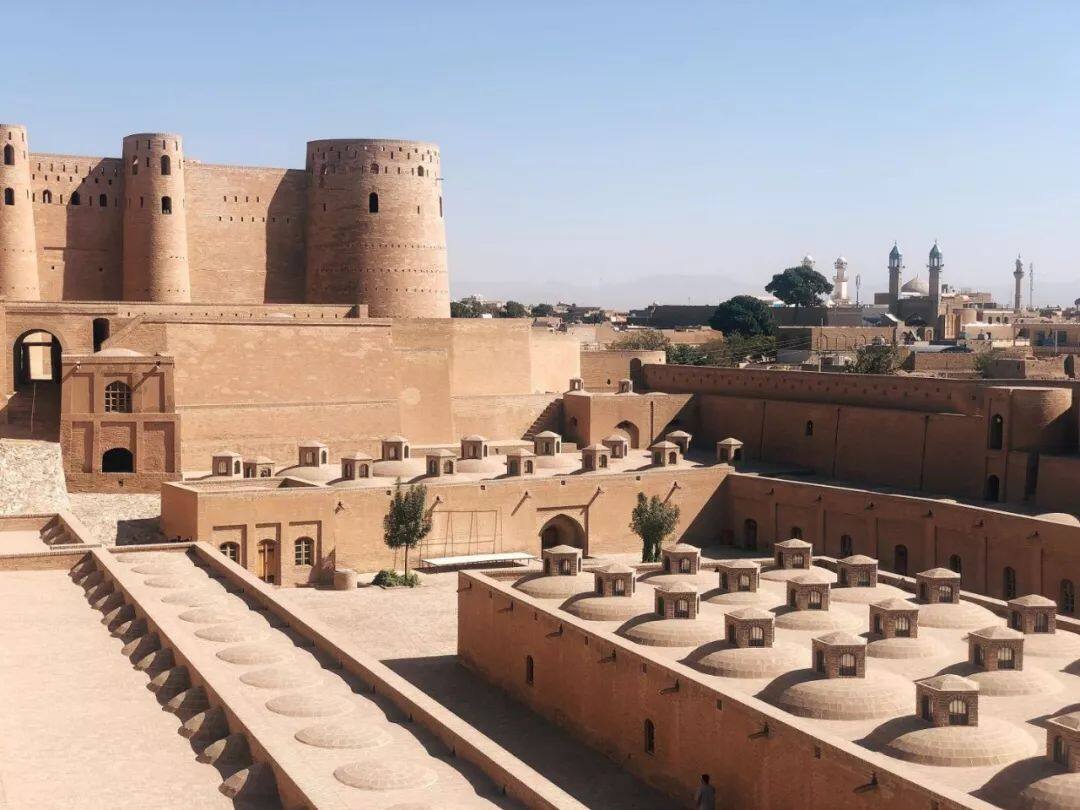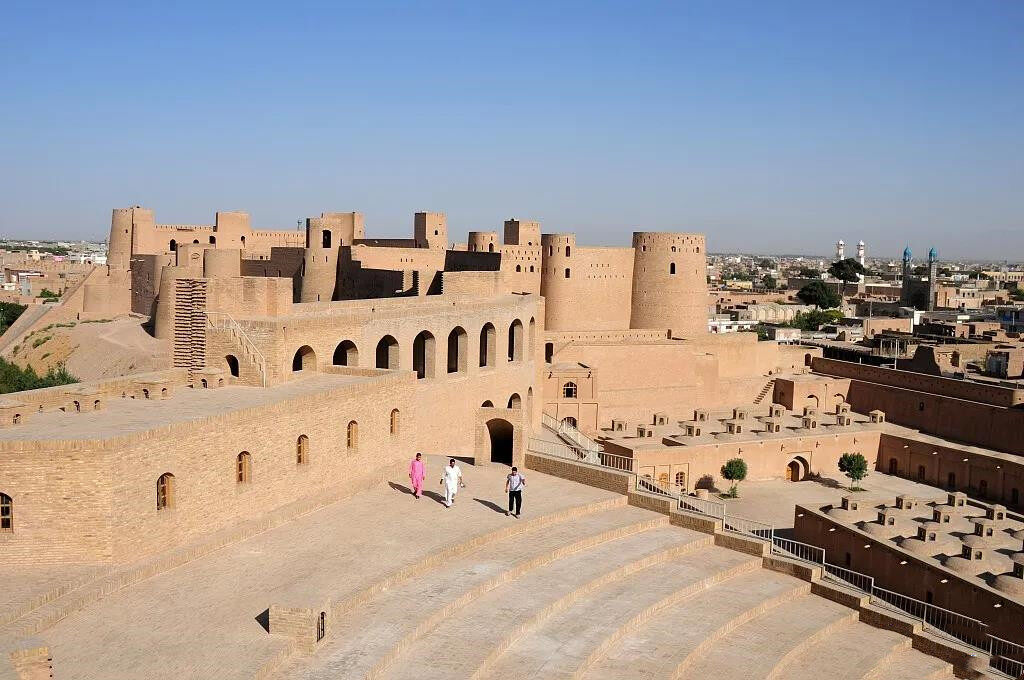- Herat has left a strong mark in the history of exchanges between European and Asian civilizations

The city of Herat in Afghanistan flourished during the ancient Persian Empire. Influenced by the Arab Conquest Movement and the Mongolian Expedition, this thousand-year-old city was in ruins several times. After the Timur dynasty settled in Herat, it continued the legacy of the Silk Road exchanges, making Herat back to its former prosperity. As one of the greatest cities in the ancient world, Herat City is also an important hub along the Silk Road, leaving a strong mark in the history of exchanges between European and Asian civilizations.
Natural and human characteristics
The Hari River originates from the Gur Mountains in the east. This river has many tributaries distributed in the north and south of Herat. The city of Herat was irrigated by the Hari River, so it was also known as Hari. It is located about 600 kilometers west of Kabul today. Due to the high altitude and far from the ocean, Herat is located in an area where the annual temperature difference and daily temperature difference are large. The temperature difference between day and night changes drastically. The air is dry. At the same time, the wind blowing from the Indian Ocean is blocked by the high mountains in the south and southeast. The amount of special precipitation is very low, mostly in winter, and there is no rain at all in summer and autumn.
Many place names in ancient Afghanistan are recorded in the "Persian Ancient Scriptures". The Herat Oasis in northwestern Afghanistan is called Halova in the book. The city of Herat is surrounded by strong walls, rich in water, and vast outskirts. For the urban distribution of Herat City, it is mainly composed of two urban areas, the old and the new, surrounded by partially well-preserved external walls. From a plane perspective, the old city is almost square, and the interior is divided into four districts. The northern part of Herat city cannot be irrigated due to its proximity to the desert land. The mountains in this area are rich in millstones and paving stones; the southern part is an orchard rich in fruit, and the vineyards here are famous for their grapes; to the east of Herat city, it is located in Halle The vast river valley area is a series of towns, namely Bashan City, Caesar City, Astarabi City, Maya Bazi City and Offa City, etc. These towns have abundant water resources and are relatively prosperous. There are orchards around each city. And the fertile land, among which the rice produced near the city of Marabazi is particularly famous and is exported in large quantities; in the western region are tracts of woods, and the timber obtained is exported in large quantities. This area is also rich in watermelons and grapes.

There are many ethnic groups and tribes living in the Herat area, mainly including Tanunni, Hazara (Dehui Janat), Jamshid, Filuzkushi and other ethnic groups. On the ancient caravan route through the Iranian plateau, the city of Herat and its surrounding areas occupies an important strategic position. Geographically, the southern part of the ancient Herat region is Sistan, the northwest is Partia, and the northeast is Daxia. In its heyday, there were 12,000 shops, 6,000 hot baths and 659 schools in the city’s market, with approximately 444,000 residents.
History of Herat
During the Persian Achaemenid dynasty in the 6th century BC, the Herat area was mentioned in the list listed in the royal inscriptions. At that time, the city of Herat and its surrounding areas were uniformly called Halle in the ancient Persian language. (Haraiva). The origin of the name Harleh comes from the Harleh River, which is 5 kilometers south of Herat. In the time of Alexander the Great, Herat was once an important strategic location. After the death of Alexander the Great, Herat became a border region between the Parthian Empire in the west and the Batria Empire in the east. At the end of the second century BC, under the attack of the Parthians, the Scythians were forced to cross the Herat region and finally settled in Sistan in the south. During this period, the area became part of the Parthian Empire. The word "Harēv" appeared in the inscriptions during the Sassanid period, and was mentioned in the catalog of the capitals of the empire, and was also listed as an area where Christianity existed.
In 652, Arab troops entered Khorasan and occupied Herat. During the Umayyad dynasty, Herat was the main area of struggle for power among Arab tribal leaders. During the Arab rule, many local dynasties emerged in the Herat region. Since then, Herat has been ruled by the Saman Dynasty, the Ghazni Dynasty and the Seljuk Empire. In 1150, the Kingdom of Guri took advantage of the decline of the Kingdom of Ghazni and included Herat into the territory of the Kingdom of Guri. During the rule of the Kuri Kingdom, Herat became an important gateway to control the Harid Valley and to the Western Islamic world. In 1221, the Mongolian army finally occupied the city of Herat after besieging the city for six months. The Mongols’ conquest caused a devastating blow to Herat, the towns were destroyed, the population dropped sharply, and agriculture and other economic activities were severely damaged. In 1236, according to the order of Genghis Khan's son, Wo Kuotai, emigration settled and the city of Herat was restored. Since then, Herat, a famous political, cultural and commercial city, has been severely damaged again after several wars.

Around the 1460s, Timur established a new country of nomadic tribes with Sistan as the center, and gradually expanded the territory to Iran, Asia Minor, Transcaucasus, Volga River Basin, Siberia, Tianshan Region, and Khwarazi. Mold and North India, and occupied Herat in 1381. In 1409, Timur's son Shaharu made his capital in Herat and divided the empire into princes in the form of beneficiaries. In 1510, the Timur dynasty was defeated by Ismaili, the founder of the Safavid dynasty of Iran, and Herat has belonged to Persia ever since. In the 16th and 18th centuries, Afghanistan was under the occupation and contention of the Mughal dynasty and the Safavid dynasty. In 1747, when the Persian Empire fell apart, Ahmadsha established the Durani dynasty, regaining Herat and With it as the capital, a unified Afghan state was formally formed.
Cultural exchanges and trade exchanges
The Silk Road is the main artery of land transportation between the east and the west in the history of the world. Afghanistan is at the hub of this artery, and Herat has undoubtedly become the intersection of many important trade routes. Herat was one of the main trading centers as early as in the Kuri Kingdom. As a cargo transfer station for caravan trade on the "Silk Road", Herat maintained business ties with China, India, and the Mediterranean countries at that time. Since the 13th century, the "Silk Road" from West Asia to China has also passed there, including a southern branch that passes through Herat on the way to Kandahar and India. Therefore, Herat became a prosperous market for the trading of various products in Asia at that time. With the establishment of the Timur dynasty, as an important city along the "Silk Road", many merchants shuttled through the Herat area. After Herat became the capital city, it gradually developed into an international commercial and cultural center in Central Asia, bringing together business travelers, scholars, officials, and craftsmen from all over the world. The rulers of the dynasty attached great importance to cultural exchanges and development, attracted outstanding scholars from all over the world through favorable conditions, and promoted the cultural prosperity of Herat.
Prosperous material and cultural exchanges and frequent personnel flows have also promoted scientific and technological exchanges among civilizations, enabling Eurasian civilizations to learn from their strengths to make up for their shortcomings, and achieve historic progress in the collision and integration of civilizations. Shaharu, the successor of Timur, was a protector of artists, scholars and poets. Under his advocacy, Herat quickly became an important center of Central Asian civilization. The magnificent palaces, libraries, gardens and parks that stand in the city add splendor to the capital. Especially during the rule of Shaharu, the Herat area was economically prosperous, commerce flourished, farmland water conservancy and handicrafts were developed, and many mosques and Muslim schools were built in the city. In addition, starting from the Shaharu period, within nearly a century, due to the rulers’ admiration of art and culture, there has been a cultural prosperity centered on the Herat region. This period is known as the "Renaissance in Afghanistan". era". As the main artery of communication between ancient Eurasia, the "Silk Road" not only flows material and culture, but also carries the scientific and technological achievements of various civilizations. Herat, as a transit point for East-West trade, is also an important node of technological exchanges on the "Silk Road". It is the smooth flow of the "Silk Road" that pushes civilizations to a new climax in scientific and technological exchanges in Herat.
Herat was not only the cultural and political center of the Timurid dynasty, but also continued to play its role as an important international trade city on the "Silk Road". In Herat, shops and various handicraft workshops are scattered throughout the streets and alleys, and the markets are full of agricultural and animal husbandry products from all over the country. The handicraft guild and the "Jimei" market, which specializes in marketing various handmade products, are in close contact with each other. Compared with cities such as Balkh, Kandahar, Ghazni, and Kabul, Herat occupies the top position in trade with China, India, Iran and Europe. During the Timurid dynasty, envoys from Herat were sent to China and India, and envoys from other countries also visited here. In 1413, Ming Chengzu sent a large delegation of 300 people to visit Herat. As the official secretary of the mission, Chen Cheng, together with Li Xian who assisted him in his work, wrote "The Journey of the Western Regions" and "The History of the Western Regions", which recorded the social customs, properties, trade, culture and religion of this large Western Region.

As the place where the key to the throat of the western section of the Silk Road, and one of the few ancient cities that have survived to this day, Herat City has left a strong mark in the history of the exchange of civilizations between Europe and Asia. Despite being conquered by Arabs and Mongols, Herat has been caught in war for many years. However, the Tamerlane Empire, which was once prosperous since then, continued the legacy of the Silk Road exchanges. It not only provided historical opportunities for the development of Herat City, but also made it a gathering place for civilized exchanges in Eurasia, making Herat Once again in the grand occasion of the Silk Road linking Europe and Asia. Editor/He Yuting
Comment
 Praise
Praise
 Collect
Collect
 Comment
Comment
 Search
Search














Write something~